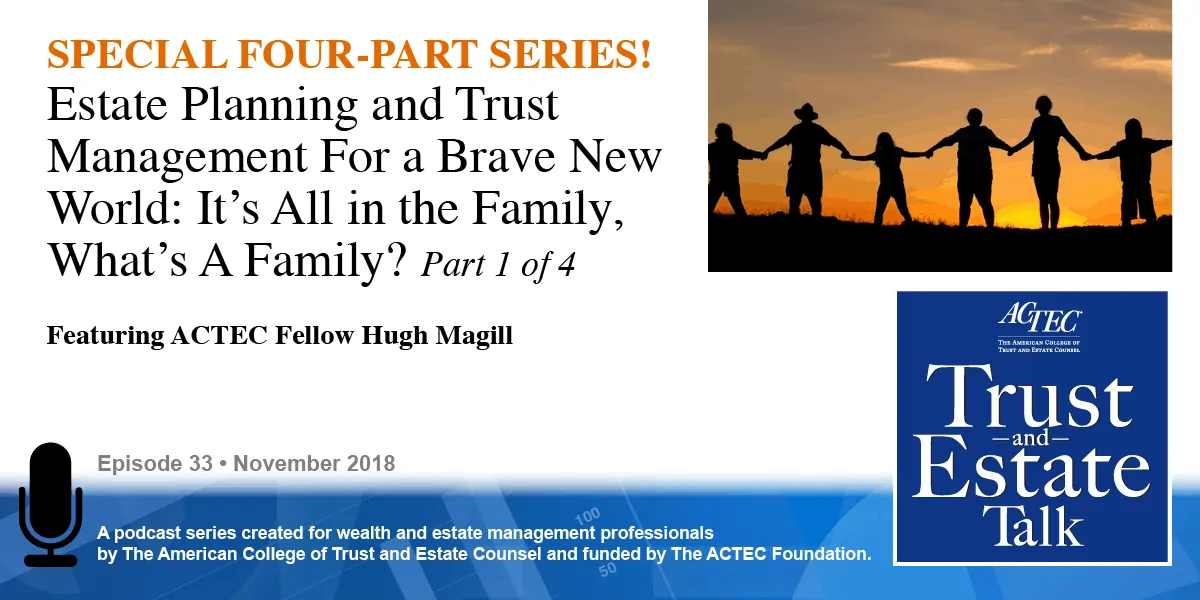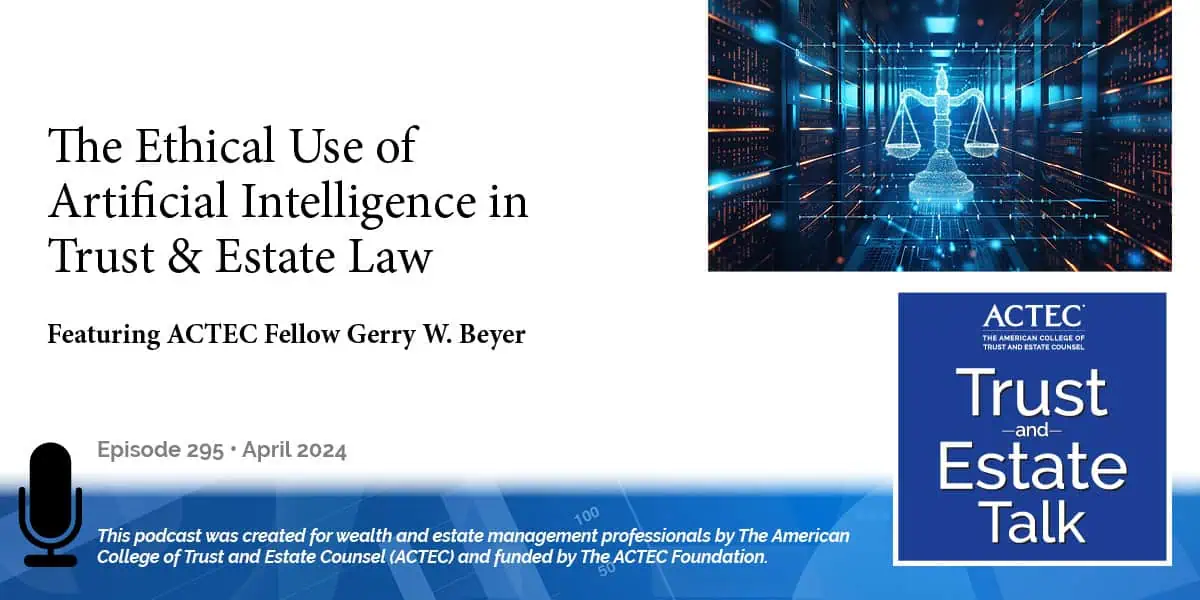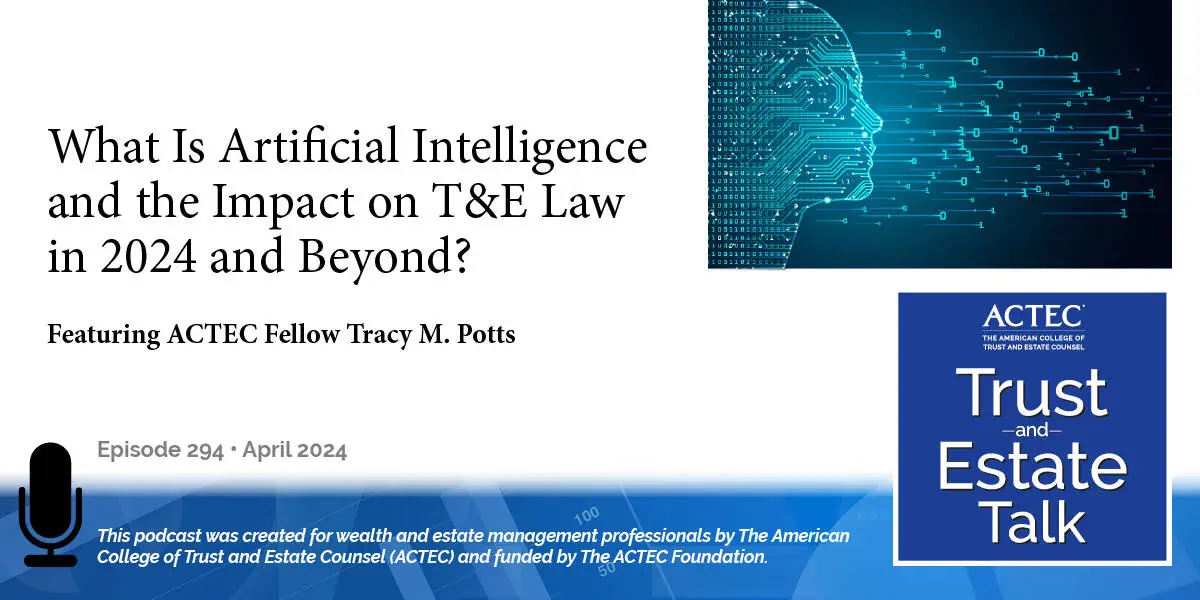Estate Planning and Trust Management for a Brave New World | Part 1 of 4

“Estate Planning and Trust Management for a Brave New World: It’s All in the Family, What’s A Family?” is a four-part special:
- Part 1 (this podcast): An introduction and overview to lecture,
- Part 2: Understanding of how changing demographics and multiple generations impact the current world of estate planning and trust management,
- Part 3: How trusts need to evolve to serve new family dynamics,
- Part 4: A look at longevity trends and its implications.
Video of full lecture with slides.
Transcript/Show Notes
“Estate Planning and Trust Management for a Brave New World: It’s All in the Family, What’s A Family?” that’s the subject of today’s Special ACTEC Trust and Estate Talk.
This is Susan Snyder, ACTEC Fellow from Chicago. Welcome to an ACTEC Trust and Estate Talk Special with Fellow Hugh Magill also from Chicago. Hugh presented the Trachtman Lecture at our Annual Meeting in March of 2018 and has given us permission to share his presentation with our audience. This podcast is an introduction and overview to the Trachtman Lecture: Estate Planning and Trust Management for a Brave New Word: It’s All in the Family, What’s a Family? Welcome Hugh.
This is a presentation that began perhaps 6 or 8 years ago when I was introduced by the chairman of our company to a family, headed by a retired CEO of several American corporations. And what was interesting about this family- he was divorced from his first wife, had remarried, he had 3 children from his first marriage and the second marriage yielded another 2 children, so there were 5 in total. What was striking about this family was the fact that, although the family looks- if you look at a family tree like a two generation family, and they are a two generation family for tax purposes- they actually comprise 4 different generations because the husband, a traditionalist, is married to a second spouse who is a boomer, the children of the first marriage are gen x-ers, and the children of the second marriage are millennials. And so there are 4 generations at play in the demographics of this single American family. So I’m going to begin by looking at the attributes of the generations who are present at either the estate planning or the trust table today, depending on how we serve them, and how those attributes are affecting a whole host of issues that influence the allocation of wealth and the functioning of these families.
We’ll look at a number of different studies- one of them will relate to longevity, the fact that all of our clients, they are living longer lives and the fact that they’re living longer lives means that their assets are going to have to work harder, inheritances may be delayed. We’re also going to look, though, at how the generational attributes are playing out in the changes occurring around the fundamental institution of marriage. Marriage rates in the United States have never been lower than they are today, they were at their peak in the 1950s when most of us as boomers were born and they’ve now declined to a level of 50%, lower than 50% of American households. So now I’m going to look at the changes with marriage but also a change in perspective about marriage and the paradigm of marriage whereas for prior generations marriage was seen as a cornerstone experience, sociologically, it was an experience upon which families were built. Today it is seen by an increasing number of Americans as a capstone experience, an experience into which one enters after living together- dating and living together- having children, achieving financial stability, etc. We’ll also look at a wide range of other family structures in the United States and wrap up with a summary of family structures today how they stand today in the United States and they break down, roughly into thirds: 31% of families today are actually household without children, 35% are what we think of as a traditional family- heterosexual couple married with biological or adopted children- and another 34% are actually modern families. These would be blended families, multigenerational families, same sex relationship, or single parent relationships. What is striking about the latter group is that when that group is surveyed about its expectations in regard to financial planning, estate planning, financial services, over 70% of them say they expect to receive solutions that are better suited to the other categories of families, those of single family households or traditional American families.
So, I’m then going to look at 4 issues that in my mind arise out of these changing demographics, the first of which is: how will wealth be allocated in these newer family structures? And we’ll look at a number of different aspects of that, one of which will be the intestacy rate in the United States, we’ll look at some other questions that surround, “how is it that wealth has been allocated with in traditional families and what can we learn about that for contemporary families?”
Second, we’ll look at how trusts need to evolve to serve these new families and particularly an environment in which we have dramatically increased exemptions from transfer taxes that repeal the rule against perpetuities, trusts are going to last a very long time and we’ll look at what I see as some of the important design elements in trusts that will serve these families and yet serve generations to come.
Third, we’ll look at longevity and some of the implications of longevity. Part of that will be around disability, another part of it will be looking at the social demographics of age distribution across the world and how there is a growing population of elderly across the world, a declining population of youth, leading to some very interesting gaps with respect to elder care and how that will be dealt with in countries across the world. Fascinating part of this is we’re going to examine different cultures, regard, care for the elderly, and who they believe it is that should provide for it, and then we’ll wrap up by looking at that issue in the United States.
The last part of this is looking at how families such as these are going to collaborate and make decisions together. Because traditional approach to this within families of the GI generation, the silent generation, was a very paternalistic model to decision-making was one that did not invite families into the estate planning process. But the expectations of millennials and gen x-ers today is very much more along the lines that they will be afforded a role in these processes. And so, boomer families who want to have these conversations I think in large part are not equipped to do so because they did not have the privilege of that conversation within their own ancestry and so I think one of our responsibilities will be equipping them to have these kinds of conversations which I think can lead to a host of better outcomes for the wide range of decisions that these families will face, particularly some of the most poignant and wrenching decisions are end of life decisions- how is it that we can help these families avoid what is often protracted conflict- protracted interpersonal conflict- when they’re making those kinds of decisions.
And then I’ll wrap up by talking a little bit about how we believe that our concepts of wealth need to be enlarged, we talk about wealth and what we really talking about is financial wealth and I’ll cite the work of Charlie Collier who is a Senior Development Officer for many years at Harvard University who developed a sort of 4 factor approach to wealth that involves human capital, social capital, intellectual capital, and finally financial capital. And, I’ll talk and finish my remarks with a story about a family, 2 generation family that undertook a fascinating process to try to define their own wealth and then take what they learned from that into all aspects of that family was going to relate to one another, make decisions together, do their estate planning, and ultimately make decisions about their financial wealth that would enhance the family’s other forms of wealth.
This concludes the Introduction to Estate Planning and Trust Management for a Brave New Word. Stay tuned for part 2 of 4 in this special ACTEC Trust and Estate Talk series which will air next Tuesday. Thank you Hugh for sharing your thoughts on family and for allowing us to post the entire lecture in the coming weeks.
This podcast was produced by The American College of Trust and Estate Counsel, ACTEC. Listeners, including professionals, should under no circumstances rely upon this information as a substitute for their own research or for obtaining specific legal or tax advice from their own counsel. The material in this podcast is for information purposes only and is not intended to and should not be treated as legal advice or tax advice. The views expressed are those of speakers as of the date noted and not necessarily those of ACTEC or any speaker’s employer or firm. The information, opinions, and recommendations presented in this Podcast are for general information only and any reliance on the information provided in this Podcast is done at your own risk. The entire contents and design of this Podcast, are the property of ACTEC, or used by ACTEC with permission, and are protected under U.S. and international copyright and trademark laws. Except as otherwise provided herein, users of this Podcast may save and use information contained in the Podcast only for personal or other non-commercial, educational purposes. No other use, including, without limitation, reproduction, retransmission or editing, of this Podcast may be made without the prior written permission of The American College of Trust and Estate Counsel.
If you have ideas for a future ACTEC Trust & Estate Talk topics, please contact us at ACTECpodcast@ACTEC.org.
Latest ACTEC Trust and Estate Talk Podcasts

The Ethical Use of Artificial Intelligence in Trust & Estate Law
A law professor offers insights into the risks, rewards, duties and ethical considerations of lawyers using AI in their T&E practices.

What Is Artificial Intelligence and the Impact on T&E Law in 2024 and Beyond?
A primer on the types and uses of AI, then a deeper dive into the impact on trust and estate law from types to applications to ethical considerations.

The IRS Ruling on Modifying a Grantor Trust
Explore the gift tax implications for trust beneficiaries modifying grantor trusts in IRS CCA 202352018, with nuanced analysis and estate planning insights.

